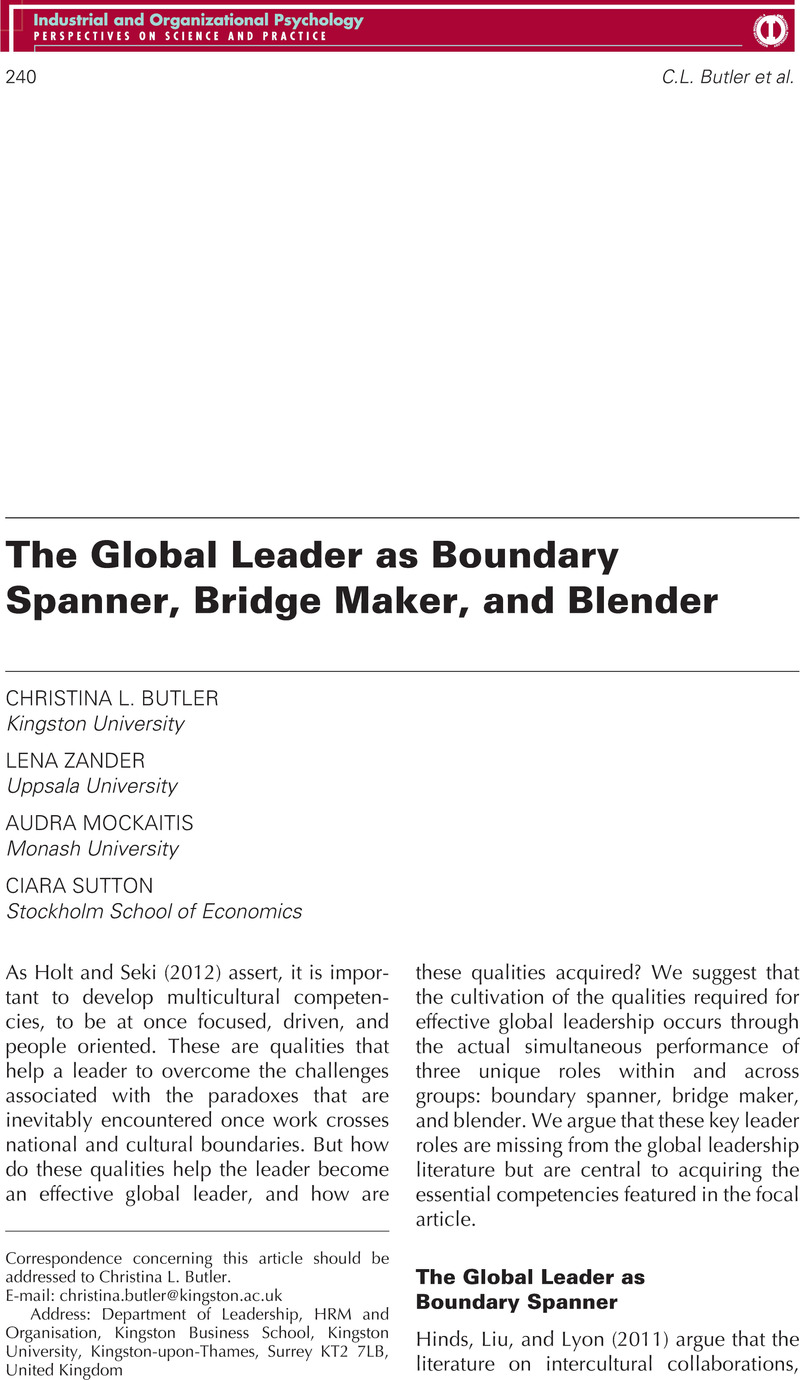Crossref Citations
This article has been cited by the following publications. This list is generated based on data provided by Crossref.
Zander, Lena
Mockaitis, Audra I.
and
Butler, Christina L.
2012.
Leading global teams.
Journal of World Business,
Vol. 47,
Issue. 4,
p.
592.
Seki, Kyoko
and
Holt, Katherine
2012.
Global Leadership to Transform the World.
Industrial and Organizational Psychology,
Vol. 5,
Issue. 2,
p.
248.
Osland, Joyce S.
Li, Ming
and
Wang, Ying
2014.
Advances in Global Leadership.
Vol. 8,
Issue. ,
p.
1.
Osland, Joyce S.
Li, Ming
and
Wang, Ying
2014.
Advances in Global Leadership.
Vol. 8,
Issue. ,
p.
1.
Lisak, Alon
and
Erez, Miriam
2015.
Leadership emergence in multicultural teams: The power of global characteristics.
Journal of World Business,
Vol. 50,
Issue. 1,
p.
3.
Tenzer, Helene
and
Pudelko, Markus
2015.
Leading across language barriers: Managing language-induced emotions in multinational teams.
The Leadership Quarterly,
Vol. 26,
Issue. 4,
p.
606.
Zander, Lena
Butler, Christina L.
Mockaitis, Audra I.
Herbert, Kendall
Lauring, Jakob
Mäkelä, Kristiina
Paunova, Minna
Umans, Timurs
and
Zettinig, Peter
2015.
The Future of Global Organizing.
Vol. 10,
Issue. ,
p.
227.
Furusawa, Masayuki
and
Brewster, Chris
2015.
The bi-cultural option for global talent management: The Japanese/Brazilian Nikkeijin example.
Journal of World Business,
Vol. 50,
Issue. 1,
p.
133.
Lelchook, Ariel
and
de Luque, Mary Sully
2015.
International Encyclopedia of the Social & Behavioral Sciences.
p.
334.
Lisak, Alon
Erez, Miriam
Sui, Yang
and
Lee, Cynthia
2016.
The positive role of global leaders in enhancing multicultural team innovation.
Journal of International Business Studies,
Vol. 47,
Issue. 6,
p.
655.
Levy, Orly
Peiperl, Maury A.
and
Jonsen, Karsten
2016.
Advances in Global Leadership.
Vol. 9,
Issue. ,
p.
281.
Ghemawat, Pankaj
and
Reiche, B. Sebastian
2016.
The Laws of Globalization and Business Applications.
p.
239.
Hanges, Paul J
Aiken, Juliet R
Park, Joo
and
Su, Junjie
2016.
Cross-cultural leadership: leading around the world.
Current Opinion in Psychology,
Vol. 8,
Issue. ,
p.
64.
Henson, Ramon
2016.
Successful Global Leadership.
p.
183.
Pekerti, Andre Anugerah
Vuong, Quan Hoang
and
Napier, Nancy K.
2017.
Double edge experiences of expatriate acculturation.
Journal of Global Mobility,
Vol. 5,
Issue. 3,
p.
225.
Tenzer, Helene
and
Pudelko, Markus
2017.
The influence of language differences on power dynamics in multinational teams.
Journal of World Business,
Vol. 52,
Issue. 1,
p.
45.
Osland, Joyce S.
Ehret, Michael
and
Ruiz, Lisa
2017.
Advances in Global Leadership.
Vol. 10,
Issue. ,
p.
41.
Schotter, Andreas P. J.
Mudambi, Ram
Doz, Yves L.
and
Gaur, Ajai
2017.
Boundary Spanning in Global Organizations.
Journal of Management Studies,
Vol. 54,
Issue. 4,
p.
403.
Shakir, Farah Y.
and
Lee, Yih-teen
2017.
Advances in Global Leadership.
Vol. 10,
Issue. ,
p.
89.
Reiche, B. Sebastian
Bird, Allan
Mendenhall, Mark E.
and
Osland, Joyce S.
2017.
Contextualizing leadership: a typology of global leadership roles.
Journal of International Business Studies,
Vol. 48,
Issue. 5,
p.
552.





